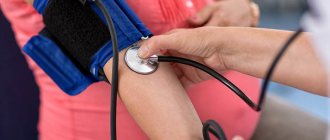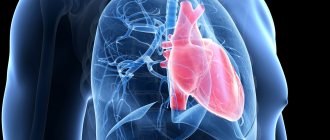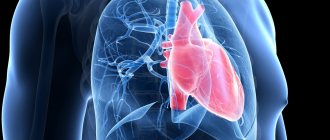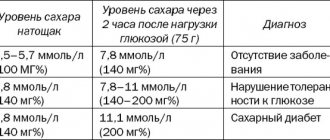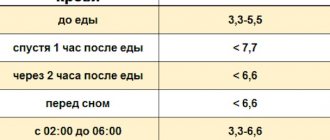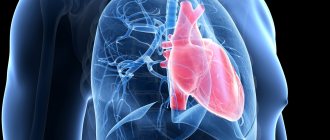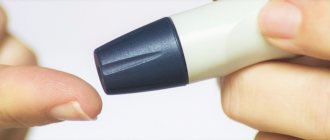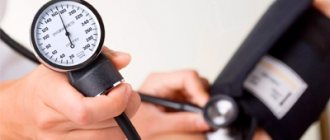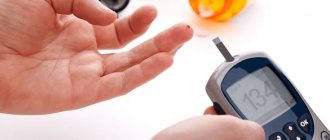Drawing up a diet and counting bread units is the basis for the treatment of many diseases, which include type 1 or type 2 diabetes. Frequent deviations from the prescribed diet or return to the diet that the patient adhered to before the diagnosis of the disease can cause a worsening of the severity of the pathological process and lead to the development of irreversible consequences. Products that contain ethyl alcohol have a negative effect even on a healthy body. Therefore, people with any type of diagnosed disease should treat alcohol consumption with due caution.
Is it okay to drink alcohol if you have type 1 diabetes?
In type 1 diabetes, the effect of ethanol on the human body is combined with the effect of insulin, which is systematically administered by injection. This combination can lead to a rapid decrease in plasma glucose levels and, as a result, the development of hypoglycemia. Therefore, patients with this type of disease can drink alcoholic beverages only after determining the concentration of glucose in the blood. If the numbers are within normal limits, then you can drink alcohol in acceptable quantities (a detailed list and dosages will be given below), but if they are lower, then you should give up drinking. It is strictly forbidden to drink alcohol on an empty stomach, as this will contribute to a rapid decrease in sugar levels.
Characteristics of beer and its effect on the body
Beer contains no fats, the protein component is scanty (only half a gram per 100 g), but it contains a sufficient amount of vitamins and minerals. The leading positions are occupied by:
- choline (vitamin B4) – takes an active part in metabolic processes;
- folic acid (B9) – helps accelerate tissue regeneration;
- fluoride – maintains the health of tooth enamel;
- potassium – regulates water balance and stabilizes cardiac activity;
- phosphorus – stimulates the functioning of the brain and muscles, participates in metabolic processes.
According to nutritionists, for a healthy person, drinking beer in small quantities is not only not dangerous, but also beneficial. When you have diabetes, not everything is so rosy. The energy value of the foamy drink, depending on the variety, ranges from 45 to 60 kcal per 100 ml. With a simple comparison of calorie content, a half-liter bottle of beer can be equated to a full-fledged cheeseburger, which is unacceptable under diabetic dietary restrictions.
The percentage of alcohol in beer is small, different varieties contain from 3.5 to 5.5%. The alcohol component is formed through the fermentation of brewer's yeast and sugars, in particular glucose. During a chemical reaction, molecules break down, releasing ethanol and carbon dioxide, which turns beer into a carbonated liquid, dangerous for people with diabetes. First, soda speeds up the penetration of alcohol and glucose into the bloodstream. Secondly, it promotes the manifestation of polyphagia (increased appetite). It is not always possible for a person to resist the desire to snack heavily. This leads to a set of extra pounds that are unacceptable for diabetics.
Does drinking beer increase blood sugar? Undoubtedly. The glycemic index of the drink reaches 110 units. Considering that diabetics are not allowed products indexed over 70 units, foam is, a priori, excluded from the diet. In type 1 diabetes, an important criterion for the ability to eat (drink) a particular product is the number of bread units (1 XE = 12 g of carbohydrates). Patients are allowed no more than 24 XE per day (290 g of net carbohydrates). 100 grams of foam, 4.5% strength, contains 3.8 g of carbohydrates.
When calculating bread units per half-liter bottle (3.8:100*500:12), it turns out about 1.6 XE. This number increases blood glucose levels by approximately 4 mmol/l from the initial values. Type 2 disease is characterized by the ability of the pancreas to synthesize insulin, but the inability of cells and tissues to perceive it. Beer has a high insulin index (108 units), indicating the degree of response to the product of the endocrine function of the pancreas.
When drinking beer, the body begins to intensively produce insulin, which the body is not able to use rationally. Against the background of glucose-lowering drugs, this can lead to hypoglycemia (a drop in blood glucose levels to the maximum possible levels). This is another reason why diabetics should avoid the foamy drink. Drinking beer if you have diabetes is extremely undesirable based on the traditions of drinking this drink. As a rule, beer libations are not limited to one half-liter bottle.
For example, in the company of friends while watching a football match, preliminary plans from the “I’m a little bit” series do not work out. For a diabetic patient, excessive drinking can pose a real threat to life and health. When asked whether or not to drink alcohol, everyone answers independently. If a diabetic makes a positive decision in favor of beer, it is necessary to know the rules for drinking an intoxicating drink and be clearly aware of the possible negative consequences.
Additionally
An alternative to beer can be homemade kvass made from rye bread and sweeteners. Chicory, nettle, and hops are suitable as useful additives.
To prepare kvass you need 450 g of rye bread, 3 liters of water, 150 g of sweetener
How does alcohol affect diabetes?
When drinking alcohol in patients with diabetes, the following processes occur in the body:
- carbohydrates that enter the body with the drink are absorbed much more slowly, which poses a danger for people with the first type of disease. An increase in insulin levels can cause cells to starve and make you feel worse. In a state of mild intoxication, you can easily miss the signs of hypoglycemia;
- some alcoholic drinks are quite high in calories and do not contain useful nutritional components that take part in carbohydrate metabolism;
- Consumption of alcoholic beverages, as a rule, significantly increases appetite, so a person can eat a large amount of food, thereby bringing his body to a state of hyperglycemia.
- ethanol, which is the main component of alcohol, contributes to disruption of the peripheral nervous system.
All patients with a history of diabetes mellitus should periodically use pharmacological medications aimed at maintaining vascular elasticity and reducing the risk of complications associated with their damage. These pathological conditions are an absolute contraindication to drinking alcohol.
What are the dangers of drinking alcohol for diabetics?
Impaired metabolism can be caused by hereditary factors, unbalanced nutrition, and significant physical and emotional stress. People with diabetes have to be especially careful when planning their diet and take a lot of medications that help fight the symptoms of the disease:
- decreased vision;
- dry and itchy skin;
- chronic weakness and fatigue;
- slow wound healing;
- increased interest in food;
- thirst, etc.
When prescribing therapy, doctors strongly recommend complete abstinence from alcoholic beverages, since they contain large amounts of carbohydrates and sugar. It is these substances that provoke an increase in blood sugar and can provoke a glycemic crisis and even coma, and with prolonged alcohol consumption and lack of treatment, lead to death. Diabetics with addiction are at particular risk, and in order to cure an alcoholic in Odessa, it is necessary to constantly monitor his condition and eliminate all alcohol-containing drinks from the diet.
Constant consumption of alcohol, even in small quantities, can provoke:
- Diseases of the liver and pancreas, in particular acute and chronic pancreatitis. Due to a decrease in the amount of glucose produced, the load on these organs increases, and very quickly they stop working normally.
- Weight gain. With diabetes, there is already a danger of weight gain, and when combined with alcohol, which provokes the accumulation of fat, the risk increases.
- Adverse reactions due to the incompatibility of alcohol and medications taken to support the heart and blood vessels.
- Increased blood pressure.
- Neurological diseases. The combined negative effect on nerve cells can trigger the development of neuropathy.
- Exacerbation and worsening of existing diseases.
Another important point is that often alcoholics with diabetes confuse the symptoms of poisoning and hypoglycemia, so they take the wrong medications. As a result, this leads to a sharp deterioration of the condition, when the patient needs to be urgently hospitalized to save life.
How much alcohol can you drink if you have diabetes?
To reduce the risk of the influence of the standard on the body of a person suffering from diabetes, you need to take into account the maximum permissible amount of alcohol:
- Strong drinks: 0.1 l – for men, 0.05 l – for women.
- Dry wine: 0.2 l—for men, 0.15 l—for women.
- Beer: 0.3 l - for men, 0.15 l - for women.
The dosage indicated above is suitable for drinking alcohol no more than once a week, unless the person’s condition has recently worsened.
Prohibited alcoholic drinks include liqueurs, sweet and fortified wines, liqueurs, and sweet alcoholic cocktails. All people with diabetes should understand that drinking alcohol in their case should be rare and strictly dosed.
Results
Diabetes mellitus does not tolerate neglect. Beer, as an exception, is allowed only in the stage of compensation of the disease, no more than once a week, in a dosage of no more than 0.33 liters. When drinking beer, it is necessary to strictly control glycemia and adjust the dose of medications used (insulin or hypoglycemic drugs). How and how long the patient can live largely depends on compliance with nutritional rules. Since beer is not considered an essential food, diabetics should avoid it.
How to reduce the harm of alcoholic beverages?
To prevent the negative effects of ethanol on the body, the following rules must be followed:
- Do not drink alcoholic beverages on an empty stomach or replace them with a full meal, as this may further increase your appetite. It is best to have a small snack beforehand and eat enough food while drinking alcohol to prevent the development of hypoglycemia.
- To reduce the energy value of wine, it is best to dilute it with clean still water.
- To prevent an excessively rapid rise in glucose levels, you need to avoid drinks with a high sugar content, which are listed above.
- After drinking alcohol, you should completely avoid physical activity.
- There is no need to mix different types of alcohol.
- You need to control the amount of calories and carbohydrates you drink and eat. This will help you effectively correct your blood glucose levels using tablets or insulin injections.
Patients with a history of diabetes mellitus sometimes find it difficult to maintain restrictions on their favorite foods or alcoholic beverages. However, it is important to remember that this disease requires strict dietary rules to be followed to prevent the development of dangerous complications.
The influence of beer on a man's appearance
As a rule, beer is consumed with various snacks, many of which are quite high in calories. However, those who think that by giving up salty snacks, they can drink beer without harming their figure are mistaken. This drink contains a large amount of carbohydrates: one half-liter bottle contains about 150 kcal. Drinking alcohol also increases your daily calorie intake, but also your appetite.
Beer in large quantities provokes the appearance of the so-called beer belly. Abdominal obesity can lead to many diseases - diabetes, cheese syndrome, high blood pressure, and in the worst case, increased bad cholesterol and metabolic problems. The fatty tissue that accumulates around the waist begins to affect internal organs, including the liver.
Write to WhatsApp
COST OF TREATMENT
Beer belly is more than just fat. It occurs as a result of chronic inflammation of the intestines caused by constant consumption of alcohol. Such inflammation can also have a very negative impact on a man’s physical performance and sex life.
The dilation of blood vessels and hydration at the cellular level that occurs due to alcohol consumption is, unfortunately, a double-edged sword. Unlike medications with pharmacological activity, which only dilate and open blood vessels, the carbohydrates contained in beer cause fluid retention in the body. This means your skin, including your face, swells and you look less attractive.
Diet
A strict diet is a necessary condition for diabetic patients. To avoid complications, it is necessary to carefully calculate the daily intake of carbohydrates, the content of which is measured in bread units (XU). A balanced diet allows you to partially compensate for carbohydrate metabolism disorders.
One of the main components of beer is malt, which is obtained by sprouting cereal crops, so the foamy drink is a product rich in carbohydrates. The spread in the number of bread units in different varieties can be large - from 0.22 to 0.49 XE. It is necessary to take this difference into account when planning your diet.
People with diabetes have an increased risk of obesity, which makes it necessary to carefully monitor the nutritional value of foods. Beer is lower in calories than strong alcoholic drinks. Depending on the manufacturing technology, 100 g contains from 29 to 53 kcal, which, as a rule, goes into the daily diet. Excess weight can also be caused by traditional types of snacks - nuts, chips and hot crackers.
About brewer's yeast
Brewer's yeast is a healthy product for the body due to the fact that it is rich in vitamins and microelements. Consumption of brewer's yeast improves well-being and stimulates liver function. Brewer's yeast is not only not prohibited for diabetics, but on the contrary, it is shown to them as a means of improving health.
Yeast, which is contained in large quantities in beer, is widely used to treat various diseases in Russia and European countries. There is already evidence of their effectiveness in the treatment of type 2 diabetes. Therefore, brewer's yeast is often used in clinics where patients with diabetes are treated.
Features of therapy
Chronic alcohol dependence is very often combined with various endocrine pathologies. In most cases, the concomitant disease remains unrecognized, as it occurs without pronounced complaints and symptoms. That is why all patients admitted to narcotics for treatment are necessarily tested by laboratory methods, including determination of blood sugar.
This measure is necessary, since detoxification drips used in the treatment of alcoholism often include a glucose solution. In this case, lack of knowledge about the diabetic problem can lead to decompensation and coma.
When a disease is detected, patients are prescribed the necessary dietary nutrition and drug support.
Detection of elevated sugar levels does not provide grounds for abandoning conditioned reflex and sensitizing methods of treating addiction. Also, this endocrine pathology does not serve as a basis for canceling coding.
Only in severe forms of the disease, accompanied by high levels of ketonemia and ketonuria, is the medicinal effect limited. In these cases, therapy is carried out primarily using hypnosuggestive techniques, acupuncture, non-drug methods, and placebo.
If a person is prone to taking psychoactive substances, having an addiction to alcohol and type 2 diabetes, he requires special supervision, both from relatives and narcologists. Such people need to regularly visit a doctor and undergo examination with a mandatory blood test for sugar. If elevated values are detected, as well as a tendency towards an increase in glucose numbers, you should consult a doctor as soon as possible.
Prolonged failure to pay attention to this problem ends in the formation of complications.
If a person has an addiction to drinking that has not developed into alcoholism, then he still requires preventive treatment. The sooner he gets rid of this imaginary pleasure, the less risk he will have of encountering a dangerous pathology.
Quitting alcohol is not as easy as it seems at first glance. Therefore, it is better not to rely on your own strength, but to immediately resort to the help of professionals who are well versed in issues of addiction. Narc doctors are always happy to help everyone who comes to us.
The text was checked by expert doctors: Head of the socio-psychological service of the Alkoklinik MC, psychologist Yu.P. Baranova, L.A. Serova, a psychiatrist-narcologist.
CAN'T FIND THE ANSWER?
Consult a specialist
Or call: +7 (495) 798-30-80
Call! We work around the clock!
Beer and male hormones
Testosterone belongs to the group of steroid hormones. It has the ability to penetrate the lipid membranes of cells and react with receptors inside them. When testosterone comes into contact with muscle cells, protein transcription is stimulated, which is directly related to tissue growth.
This hormone is produced mainly in the testicles, and in small quantities in the adrenal cortex. The signal for the testicles to begin producing testosterone is luteinizing hormone, which is produced by the pituitary gland of the brain. When drinking alcohol, the testicles still receive the same signal to act, but due to the toxic effects of ethanol, the Leydig cells responsible for producing testosterone stop working, which leads to a decrease in testosterone levels. Since beer is often consumed regularly and in large quantities, it is in many cases responsible for reducing the level of the male hormone.
If you abuse alcohol, withdrawal from binge drinking at home should be done under the supervision of specialists. From us you can order a call from a narcologist to your home.
How does ethanol affect a person with diabetes?
Even a small dose can trigger a pathological chain reaction leading to serious problems. If the patient drinks a lot, then he will definitely develop negative consequences and decompensation.
The following disorders occur from ethanol entering the blood:
- Glucose levels rise sharply.
- Blood pressure numbers are increasing.
- Appetite increases, as a result of which the diabetic forgets about dietary restrictions.
- Development of incompatibility reactions between ethanol and a number of medications used.
- Autonomic disorders, accompanied by dizziness, weakness, unsteadiness of gait, trembling throughout the body, excessive sweating, pain.
The severity of the described problems depends on the weight of the patient, the duration of the disease, and the dose taken.
Therefore, if there is still an urgent need to drink alcohol with type 2 diabetes, then you can allow yourself only a small amount containing minimal amounts of sugar. It is advisable to avoid vodka, cognac and other strong drinks completely. Sweet wines and beer can cause negative consequences even when consumed in small doses. It is better to drink alcohol no more than once every 2-3 weeks. Wine and vodka products are strictly contraindicated in hypoglycemic conditions.

